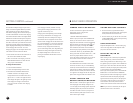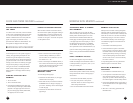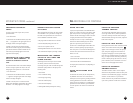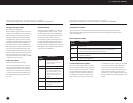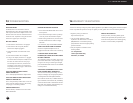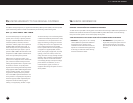
E10 OPERATION MANUAL
2120
LISTENING TO SHORTWAVE STATIONS continued
SELECTING A SHORTWAVE
METER BAND WITH THE E10
All 14 of the international broadcast bands can be
accessed with the E10.The bands are numbered
120, 90, 75, 60, 49, 31, 25, 22, 19,16, 15, 13 and
11 meters and are commonly called ‘Meter Bands’.
The E10 offers two ways to access a shortwave
band. Each method places the tuner at the begin-
ning of the band’s frequency range.
1. Each successive quick, short press of the button
labeled SW METER BAND (16) places the radio at
the beginning of a band.While pressing the but-
ton, the band number shows in the upper right cor-
ner of the display (50) and disappears a few sec-
onds after it is released, causing the clock to reap-
pear in the corner. Start tuning only after the clock
reappears. If you don’t wait, then method 2, below
will automatically be used.
2. Perform one quick, short press of the button
labeled SW METER BAND, immediately followed by
quick, short presses of either the Up/Hour or
Down/Min. tuning buttons.The band number
appears in the upper right corner of the display.
Once the band of choice is selected, start tuning
after the clock reappears in the upper right corner.
AUTO-SCAN TUNING WHILE IN
SHORTWAVE
In shortwave, auto-scan tuning scans in the short-
wave frequency ranges noted in the Band Chart
below.To tune shortwave frequencies that are in-
between these ranges, or outside of these ranges,
use one of the other tuning methods, e.g. Regular
Tuning (manual tuning) or Direct Frequency Entry
as discussed titled TUNING IN STATIONS.
11 LISTENING TO SHORTWAVE STATIONS
Are you new to shortwave listening? If so, you’ll
want to read this section and the next section
called UNDERSTANDING SHORTWAVE BANDS.
WHAT ARE SHORTWAVE STA-
TIONS?
These are radio broadcast stations around the
world broadcasting on frequencies that can be
heard over vast distances, often many thousands of
miles. In the United States, there are also about 30
domestic shortwave broadcasters with religious,
politically and ideologically oriented broadcasts.
WHY LISTEN TO SHORTWAVE
STATIONS?
There are many reasons why you may enjoy short-
wave stations. Here are just some, as reported to
us by our customers.
• Listening to news and information from other
world sources often exposes you to different and
unique perspectives on national and world events.
• Exposure to other languages and cultures,
including their music and perspectives. Hearing a
country’s native or ‘folk’ music can be very enjoy-
able, even if you don’t understand the language.
• Learning a language by hearing native speakers.
• Keeping in touch with another part of the world,
perhaps your original homeland or that of your
family’s heritage.
• Religious, politically and ideologically oriented
broadcasts.
GENERAL SHORTWAVE ‘RULES-
OF-THUMB’
• Night shortwave reception is usually better than
daytime shortwave.This can change from time-to-
time, so it’s worth checking the bands during the
day too.
• During daytime the most active shortwave bands
are 13, 15, 16, 19, and 22 meters. 16 and 19 usu-
ally being the best.At night, the most active bands
are 25, 31, 41 and 49 meters, with 31 and 49 usu-
ally best.
• Around sunset and sunrise, both the day and
night bands may be good, sometimes exceptionally
good. Listening at these times can often be quite
rewarding.
• The construction materials of some buildings
severely block shortwave signals.To counteract this,
hold the radio in your hands and get very close to
a window.






